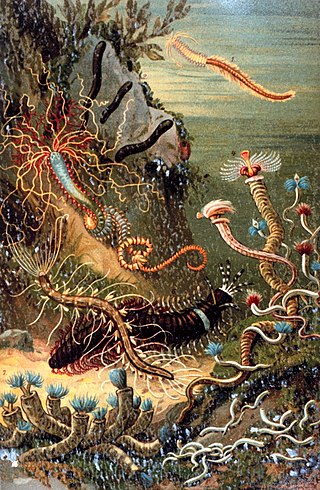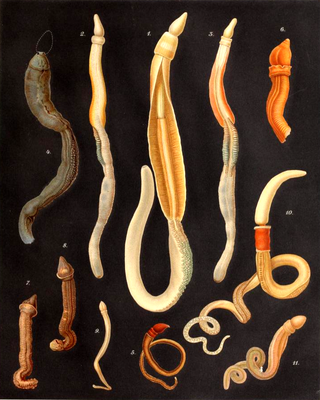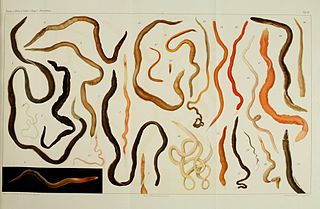
Polychaeta is a paraphyletic class of generally marine annelid worms, commonly called bristle worms or polychaetes. Each body segment has a pair of fleshy protrusions called parapodia that bear many bristles, called chaetae, which are made of chitin. More than 10,000 species are described in this class. Common representatives include the lugworm and the sandworm or clam worm Alitta.

The genus Glycera is a group of polychaetes commonly known as bloodworms. They are typically found on the bottom of shallow marine waters, and some species can grow up to 35 cm (14 in) in length.

Oligochaeta is a subclass of animals in the phylum Annelida, which is made up of many types of aquatic and terrestrial worms, including all of the various earthworms. Specifically, oligochaetes comprise the terrestrial megadrile earthworms, and freshwater or semiterrestrial microdrile forms, including the tubificids, pot worms and ice worms (Enchytraeidae), blackworms (Lumbriculidae) and several interstitial marine worms.

The acorn worms or Enteropneusta are a hemichordate class of invertebrates consisting of one order of the same name. The closest non-hemichordate relatives of the Enteropneusta are the echinoderms. There are 111 known species of acorn worm in the world, the main species for research being Saccoglossus kowalevskii. Two families—Harrimaniidae and Ptychoderidae—separated at least 370 million years ago.

Nereididae are a family of polychaete worms. It contains about 500 – mostly marine – species grouped into 42 genera. They may be commonly called ragworms or clam worms.

Eunicidae is a family of marine polychaetes. The family comprises marine annelids distributed in diverse benthic habitats across Oceania, Europe, South America, North America, Asia and Africa. The Eunicid anatomy typically consists of a pair of appendages near the mouth (mandibles) and complex sets of muscular structures on the head (maxillae) in an eversible pharynx. One of the most conspicuous of the eunicids is the giant, dark-purple, iridescent "Bobbit worm", a bristle worm found at low tide under boulders on southern Australian shores. Its robust, muscular body can be as long as 2 m. Eunicidae jaws are known from as far back as Ordovician sediments. Cultural tradition surrounds Palola worm reproductive cycles in the South Pacific Islands. Eunicidae are economically valuable as bait in both recreational and commercial fishing. Commercial bait-farming of Eunicidae can have adverse ecological impacts. Bait-farming can deplete worm and associated fauna population numbers, damage local intertidal environments and introduce alien species to local aquatic ecosystems.

Worms are many different distantly related bilateral animals that typically have a long cylindrical tube-like body, no limbs, and no eyes.
Abarenicola pacifica or the Pacific lugworm is a large species of polychaete worm found on the west coast of North America and also in Japan. The worms live out of sight in burrows under the sand and produce casts which are visible on the surface.

Maotianshania cylindrica is an extinct worm-like creature of average size. It occurs in the Lower Cambrian (Atdabanian) Chengjiang biota of Northeastern Yunnan, China. It is usually preserved as pink impression. The gut is a dark central zone. The anterior pharnyx and "collar", carry tiny sepia-colored teeth. The very back-end of the body has two small hooks.
Listriolobus pelodes is a species of marine spoon worm. It is found in shallow seas in the North East Pacific off the coast of California. It lives in a burrow in soft sediments.

The annelids, also known as the segmented worms, are a large phylum, with over 22,000 extant species including ragworms, earthworms, and leeches. The species exist in and have adapted to various ecologies – some in marine environments as distinct as tidal zones and hydrothermal vents, others in fresh water, and yet others in moist terrestrial environments.
Odontosyllis phosphorea, commonly known as a fireworm, is a polychaete worm that inhabits the Pacific coast of North and Central America. The organism normally lives in a tube on the seabed, but it becomes bioluminescent when it rises to the surface of the sea during breeding season.

Phyllodoce mucosa is a species of polychaete worm in the family Phyllodocidae. It is found intertidally in both the Pacific and Atlantic Oceans, typically on sandy or muddy seabeds.

Phyllodocidae is a family of polychaete worms. Worms in this family live on the seabed and may burrow under the sediment.

Scolelepis squamata is a species of polychaete worm in the family Spionidae. It occurs on the lower shore of coasts on either side of the Atlantic Ocean.

Cerebratulus marginatus is a proboscis worm in the family Lineidae. This ribbon worm has an Arctic distribution, and in the North Atlantic Ocean ranges as far south as Cape Cod and the Mediterranean Sea while in the Pacific Ocean it extends southwards to California.

Eunice aphroditois is a benthic bristle worm of warm marine waters, found in the Atlantic Ocean and the Indo-Pacific. It ranges in length from less than 10 cm (4 in) to 3 m (10 ft). Its iridescent cuticle produces a wide range of colors, from black to purple. This species is an ambush-predator; it hunts by burrowing its whole body in soft sediment on the ocean floor and waiting until its antennae detect prey. It then strikes with its sharp mouthparts. It may also be found among coral reefs.
Sternaspidae, commonly known as mud owls, are a family of marine polychaete worms with short swollen bodies. They have a global distribution and live buried in soft sediment at depths varying from the intertidal zone to 4,400 m (14,400 ft).
Maxmuelleria lankesteri is a species of spoon worm in the family Bonelliidae. It is found in the North Atlantic Ocean. It burrows into soft sediment on the seabed, mostly in deep water.
Glycera dibranchiata, also known as one variant of bloodworm, are segmented, red marine worms that grow up to 14-inches in length and have unique copper teeth made up of a mixture of protein, melanin and 10% copper. This copper concentration is the highest among any animal.












